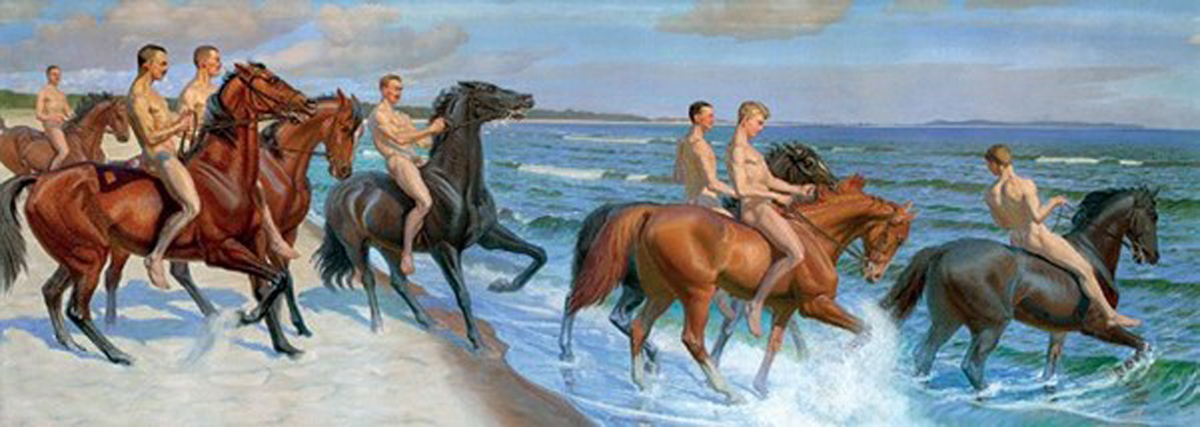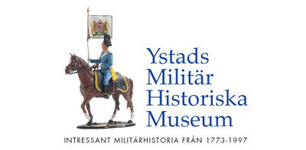The Dragoon Epoch in Ystad 1882-1927
| In 1882, the Scanian Dragoon Regiment K6 was transferred to the barracks on Stora Södergatan and the Hussars withdrew from Ystad. [K 6]
(19) In 1894, as a result of the great efforts of Elis Nilsson, Captain of the Southern Scanian Regiment; member of the Town Council of Ystad and the Swedish Parliament made the decision to relocate the Scanian Dragoon Regiment to Ystad. In 1897, Dragoons were gathered in the newly built barracks where we are now. In 1912, when construction was complete, Ystad could boast that the largest cavalry regiment in the whole of Europe was stationed here. It was comprised of 1200 horses and all the staff required for a regiment of that size. At that time (20) The horse on your right was called Hasard, he was born 1897 and was the last “Rusthåll” horse. (21) A Dragoon accommodation from about 1910. (22) Wooden horses were used for training purposes to simulate battles on horseback. (23) In 1896, the first military music corps, the Scanian Dragoons Regimental Music Corps, was established in Ystad. Since then, military music has been a greatly appreciated source of entertainment in Ystad. The musical tradition is carried on today by the Home Guards Music Corps. (24) (25) Descriptions and drawings depicting every day life in the regiment. (26) “When the Lady Cook came to the Regiment”. Civilian women started working as cooks for the army units in the beginning of the 20th century. Previously the kitchen had all-male staff. (27) In 1906, the Ystad Branch of the Swedish Red Cross was established. Some of its history is described in a stand on the right-hand side of the room. |
(28) is a portrait of Colonel Berch, who was Commanding Officer of the Scanian Dragoons, 1907-14. The story goes that the artist painted over the medals and epaulette on one of the shoulders when the work was finished as the Colonel had complained that the painting, he had commissioned was far too expensive!
(29) The glass display case on the left shows The Silver Timpani (kettledrums) with embroidered Timpani covers donated to the Dragoon Officer Corps in 1773 by Duke Carl, brother of King Gustav III. (30) “Cederholmaren” was the second example of the first self-propelled car produced in Sweden, a “steam car” that was manufactured in 1894 in the town of Ystad by the Cederholm brothers. (31) In the far corner you can see the sort of décor you would have seen in the Officers’ Mess around 1900. A number of objects from the Scanian Dragoon Regiment are also displayed. The Dragoons were a so-called “Rank Regiment” as a considerable number of the officers came from the ranks of the Swedish nobility. In 1900, 70% of the officers were in fact noblemen. By 1926 the number had decreased to 49%. (32) Due to a decision by Parliament in 1925, a lot of changes were instigated in the Swedish Army and the number of military personnel was greatly reduced. One of the consequences was that the Dragoon Regiment left Ystad in 1927. (35) The Southern Scanian Infantry Regiment [I 25] was renamed [I 7] and was transferred from Lund to Ystad during the Spring of 1928. Below: Oscar Matthiesens “Scanian Dragoon Officers Riding to Bathe”(B) Also see Gerhard Nordströms “Mort Hommes” här. |
 Matthiesen used an al-fresco painting technique. It was completed in 1906 on the stage and in the foyer of the Ystad Theatre. The painting then went on tour and attracted 120,000 visitors in Copenhagen and then continued on to Stockholm, Berlin, Munich, Riga, St. Petersburg and Moscow. In 1953 the painting was presented to the town of Ystad.
|
|


